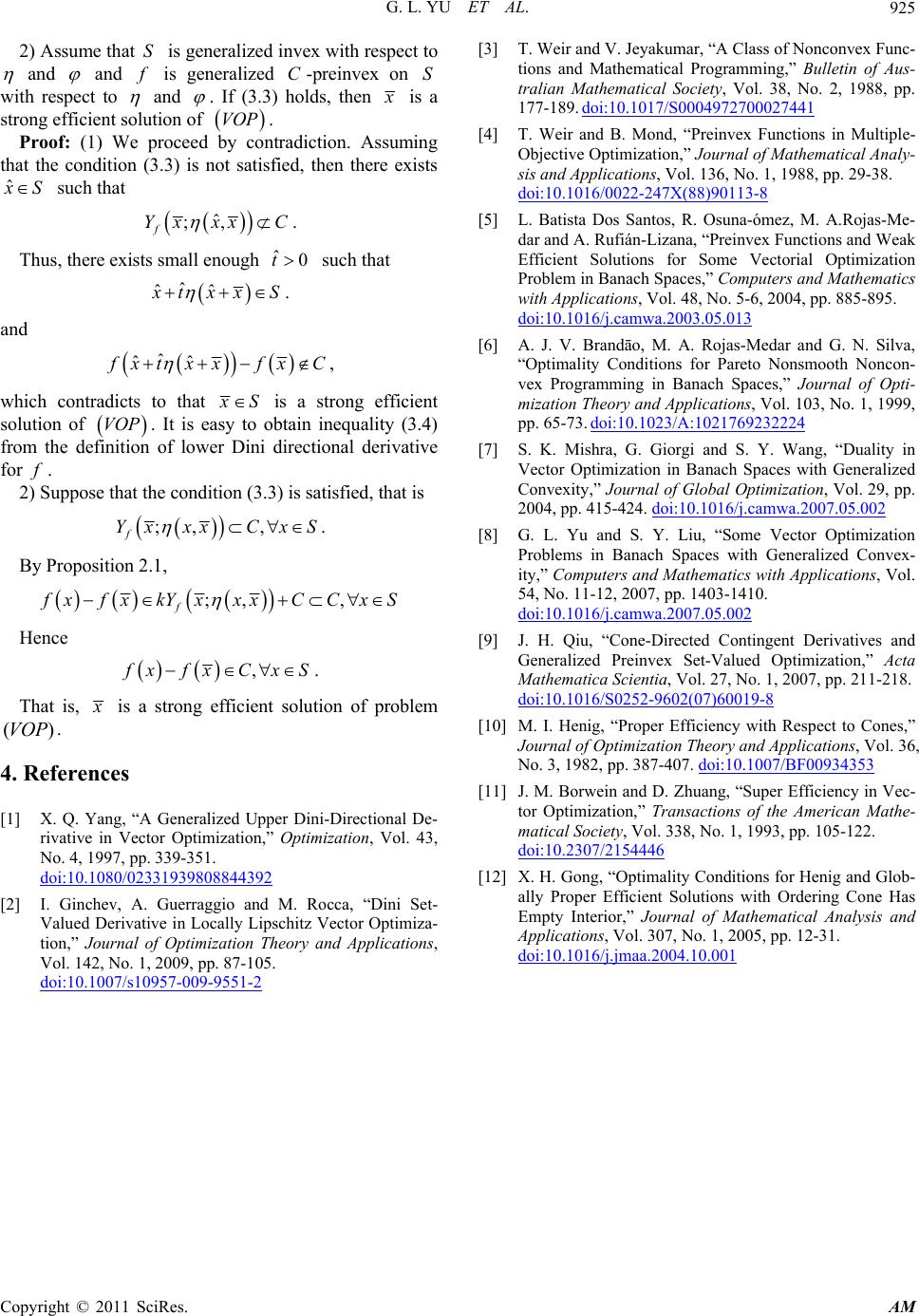
G. L. YU ET AL.
Copyright © 2011 SciRes. AM
925
[3] T. Weir and V. Jeyakumar, “A Class of Nonconvex Func-
tions and Mathematical Programming,” Bulletin of Aus-
tralian Mathematical Society, Vol. 38, No. 2, 1988, pp.
177-189. doi:10.1017/S0004972700027441
2) Assume that is generalized invex with respect to S
and
and
is generalized -preinvex on
with respect to
C S
and
. If (3.3) holds, then
is a
strong efficient solution of .
VOP [4] T. Weir and B. Mond, “Preinvex Functions in Multiple-
Objective Optimization,” Journal of Mathematical Analy-
sis and Applications, Vol. 136, No. 1, 1988, pp. 29-38.
doi:10.1016/0022-247X(88)90113-8
Proof: (1) We proceed by contradiction. Assuming
that the condition (3.3) is not satisfied, then there exists
ˆ
S such that
ˆ
;,
f
Yx xxC
. [5] L. Batista Dos Santos, R. Osuna-ómez, M. A.Rojas-Me-
dar and A. Rufián-Lizana, “Preinvex Functions and Weak
Efficient Solutions for Some Vectorial Optimization
Problem in Banach Spaces,” Computers and Mathematics
with Applications, Vol. 48, No. 5-6, 2004, pp. 885-895.
doi:10.1016/j.camwa.2003.05.013
Thus, there exists small enough such that
ˆ0t
ˆ
ˆˆ
txxS
.
and [6] A. J. V. Brandāo, M. A. Rojas-Medar and G. N. Silva,
“Optimality Conditions for Pareto Nonsmooth Noncon-
vex Programming in Banach Spaces,” Journal of Opti-
mization Theory and Applications, Vol. 103, No. 1, 1999,
pp. 65-73. doi:10.1023/A:1021769232224
ˆ
ˆˆ
xt xxfxC
,
which contradicts to that
S
is a strong efficient
solution of . It is easy to obtain inequality (3.4)
from the definition of lower Dini directional derivative
for
VOP
.
[7] S. K. Mishra, G. Giorgi and S. Y. Wang, “Duality in
Vector Optimization in Banach Spaces with Generalized
Convexity,” Journal of Global Optimization, Vol. 29, pp.
2004, pp. 415-424. doi:10.1016/j.camwa.2007.05.002
2) Suppose that the condition (3.3) is satisfied, that is
;, ,
f
Yx xxCxS
. [8] G. L. Yu and S. Y. Liu, “Some Vector Optimization
Problems in Banach Spaces with Generalized Convex-
ity,” Computers and Mathematics with Applications, Vol.
54, No. 11-12, 2007, pp. 1403-1410.
doi:10.1016/j.camwa.2007.05.002
By Proposition 2.1,
;, ,
f
xfxkYxxx CCxS
Hence [9] J. H. Qiu, “Cone-Directed Contingent Derivatives and
Generalized Preinvex Set-Valued Optimization,” Acta
Mathematica Scientia, Vol. 27, No. 1, 2007, pp. 211-218.
doi:10.1016/S0252-9602(07)60019-8
,
xfxCxS.
That is,
is a strong efficient solution of problem
.
)(VOP [10] M. I. Henig, “Proper Efficiency with Respect to Cones,”
Journal of Optimization T h eory and Application s, Vol. 36,
No. 3, 1982, pp. 387-407. doi:10.1007/BF00934353
4. References [11] J. M. Borwein and D. Zhuang, “Super Efficiency in Vec-
tor Optimization,” Transactions of the American Mathe-
matical Society, Vol. 338, No. 1, 1993, pp. 105-122.
doi:10.2307/2154446
[1] X. Q. Yang, “A Generalized Upper Dini-Directional De-
rivative in Vector Optimization,” Optimization, Vol. 43,
No. 4, 1997, pp. 339-351.
doi:10.1080/02331939808844392 [12] X. H. Gong, “Optimality Conditions for Henig and Glob-
ally Proper Efficient Solutions with Ordering Cone Has
Empty Interior,” Journal of Mathematical Analysis and
Applications, Vol. 307, No. 1, 2005, pp. 12-31.
doi:10.1016/j.jmaa.2004.10.001
[2] I. Ginchev, A. Guerraggio and M. Rocca, “Dini Set-
Valued Derivative in Locally Lipschitz Vector Optimiza-
tion,” Journal of Optimization Theory and Applications,
Vol. 142, No. 1, 2009, pp. 87-105.
doi:10.1007/s10957-009-9551-2